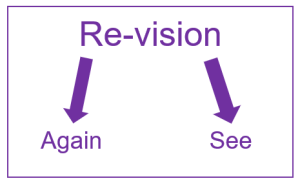10 How do I Revise my Work?
The secret to revision is in the word itself: see your work again.

Ever sent a text that you wish you hadn’t? Ever said something embarrassing or hurtful that you wished you could take back? Everyone makes mistakes in communicating their ideas, but when you write, your words are permanent. It’s important to make sure your written texts communicate exactly what you intend them to say.
- For ENGL-090 and ENGL-095, you will write responses to writing prompts, which will guide your communication. The first step in revising an assignment is to return to its writing prompt and confirm that you have followed the directions for the assignment.
- This may seem like an odd thing for a writer to check, but many times, students start off writing a paper that answers the assigned writing prompt but then goes off in a different direction. A paper informing readers of the benefits of attending college may turn into a passionate narrative about returning to college as an adult, or an argument against working full-time and attending college full-time. Always return to the assigned writing prompt once you complete your first draft and see how you have answered the assignment’s required points.
- The next thing to do in “re-seeing” your essay is to outline it. Hopefully, you used an outline to write it: great! But hide that first outline and treat your newly-completed draft as a new-to-you document and outline it.
- Introduction: does your paper have an engaging opening?
- What is the topic?
- What is the author’s credibility—is there an article or other outside source identified in the introduction? Or does the introduction present the author as a credible source?
- What is the thesis: can you highlight it as a whole, separate sentence? What is the purpose of this essay: to inform, or to persuade?
- Who is the target audience?
- Introduction: does your paper have an engaging opening?
-
- Body of the essay
- Does the first sentence of every body paragraph identify the topic of the paragraph?
- Does each paragraph have at least 4-7 sentences? Count your periods.
- Are quotes or paraphrases sandwiched: introduced, stated, and commented upon?
- Is there a wrap-up sentence for each paragraph? Remember: a paragraph is structured like a miniature essay with a beginning, middle, and concluding sentence.
- Body of the essay
-
- Conclusion
- Does the conclusion circle back to the engaging opening of the essay? Comment on the anecdote or quote you used, or answer the question if you opened with one.
- Does the conclusion restate, in different words, the 3-5 main points of your essay?
- Does the conclusion end with a sentence or two that connects your essay’s topic to a wider audience: how is this topic relevant to readers, or, in other words, why should they care?
- Conclusion
If you can rewrite to answer all of these questions, you’re ready to move onto the next step: proofreading.
